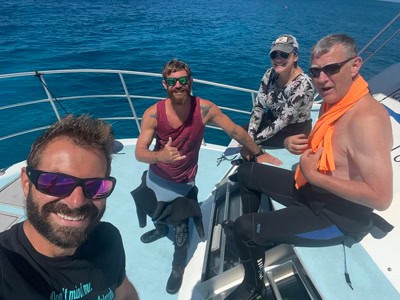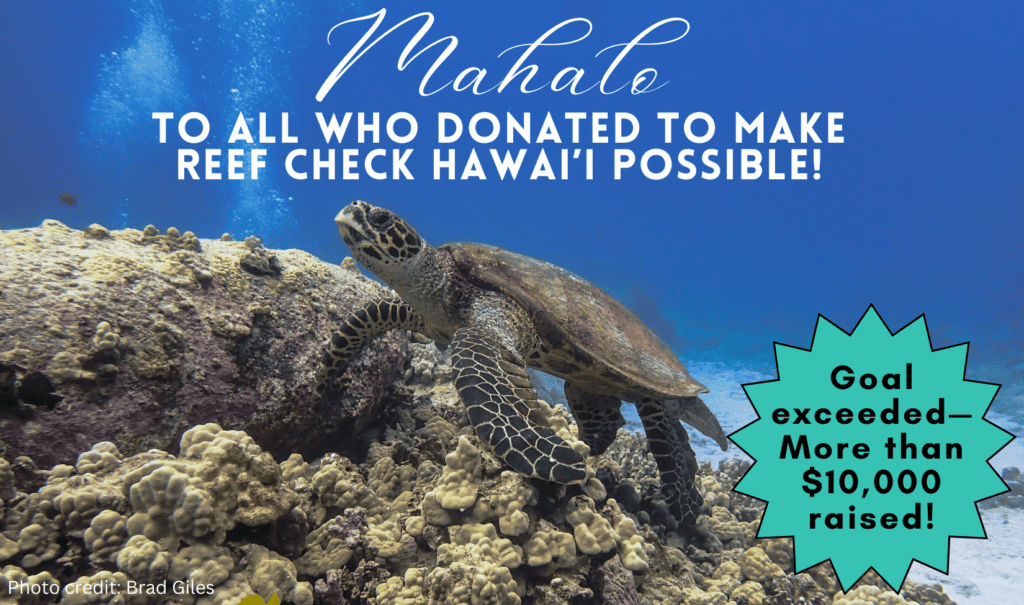
By Julian Hyde, Reef Check Malaysia CEO
I’ve been in Hawai’i for two weeks now, helping a fledgling Reef Check Hawai’i to get established. I haven’t actually done much training recently – or diving, come to that! But it’s been reassuring that it comes back quickly!
Diving here is interesting. The reefs are not as diverse as in Malaysia—not surprisingly, given that Malaysia is part of the Coral Triangle. But the water quality is great, and there are ample opportunities to spot megafauna. Two days ago, a manta ray slid slowly past our team while we were doing surveys; today, a 4-meter tiger shark came to visit the team on a training dive!
The Goal of the EcoDiver Training in Hawai’i

Our primary goal is to get a team of divers certified up to EcoDiver Trainer, so they can build a bigger team. That is going amazingly well, and the local team – Brad Giles, Rachel Yoder and Adam Florea, have been very passionate and committed to the training – which we are somehow doing around their regular working shifts in the dive center that is supporting this effort. So early starts and long days all around!
They have an ambitious goal to set up a survey program covering some 90 sites by the middle of next year, focusing on the main island (which is often referred to as “The Big Island” but is actually called Hawai’i) but also expanding to some of the other islands.
Marine Conservation in Hawai’i
Hawai’i is home to the Papahānaumokuākea Marine National Monument, the largest Marine Protected Area (MPA) in Hawai’i and one of the largest in the world. It covers the Northwestern Hawaiian Islands. There is some monitoring going on at the other islands, mainly conducted by the Division of Aquatic Resources, which manages the state’s Marine Life Conservation Districts, which are the state’s MPAs. What RC Hawai’i hopes to do is similar to what we are doing in Malaysia – getting volunteers involved as “citizen scientists” to provide more data on what is happening to the reefs around all the islands.

What is most interesting is the parallels between Hawai’i and Malaysia. The threats to the reefs are the same – local threats such as pollution, overfishing and impacts from tourism, and global threats such as climate change. There has historically been little involvement of local stakeholders in monitoring and management and the local indigenous population in Hawai’i seems to be somewhat marginalized – sound familiar? But from what I have been told, they are keen to participate where possible – just as in our own islands in Malaysia.
Hopefully, this will be the start of a great partnership! I’m hopeful that I will be able to keep in touch with the team here, and share what we have learned about setting up a Reef Check operation in Malaysia – if nothing else, so they can avoid the mistakes we made!
Our gratitude to the Reef Check Foundation
Finally a quick word of thanks to Reef Check Foundation who helped to set this up, and who have done fundraising for it; and to Jack’s Diving Locker here in Kona, Hawai’i, who have provided all the diving logistics for the training.
Good luck to the newest RC chapter – Reef Check Hawai’i!
Next stop on my trip – to meet RC Dominican Republic and learn about their experience actually managing MPAs. After that – Cali, Colombia, to attend COP 16, the UN’s conference on biodiversity. As mentioned previously, it’s going to be a very interesting conference; COP 15 two years ago agreed on biodiversity conservation targets; this time it’s about setting up the mechanisms and funding to make those targets real.

 Subscribe to Newsletter
Subscribe to Newsletter Donate
Donate Shop
Shop 0
0









